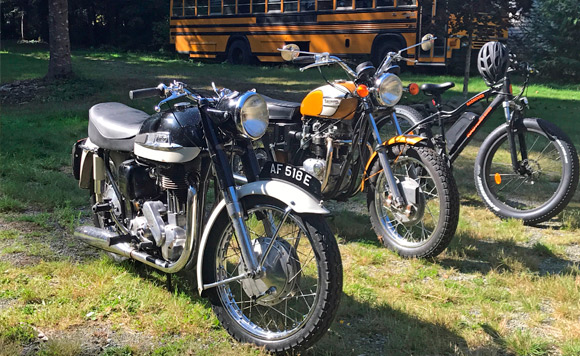by Chris Cowland –
It seems that every other bike on the road nowadays is a Harley or a Honda, but in my youth, you would rarely see either one in England. But there are groups of enthusiasts around the world who own “real” motorcycles, those made in England around 50 years ago.
The heyday of British motorcycles was in the 1960s and 1970s, with magnificent machines with truly evocative names, such as the Vincent Black Shadow, the BSA Rocket Gold Star, the Triumph Bonneville, the Norton Dominator, the Ariel Huntmaster and the Velocette Venom. These bikes handled as well as they looked, and even today you can see advertisements for extremely low mileage examples of many of these marques.
However, the more astute would-be purchaser might be curious to explore the reason for this low mileage and lack of use.
Well, most of these bikes had a single massive cylinder, so imagine a heavy piston rushing upwards, changing direction, then rushing downwards thousands of times every minute. The vibrations would be so bad that they created a thriving market for replacement headlights, footrests, side stands, rear mudguards and every other ancillary part that was not welded solidly to the frame! You know there is a problem when the riders’ instruction manual recommends that you “check the oil level and tightness of key nuts and bolts before every excursion.”
There used to be a joke about English bikes: “If it isn’t leaking oil, it must be empty.”
The brakes on these early bikes consisted of two semi-circular metal shoes covered with friction material, which would expand outwards inside a metal drum when you pulled the brake lever. Luckily, the Morris Minor driver who slammed on his brakes right in front of you had an identical woefully inadequate set-up, so you would both sail on for hundreds of feet maintaining a precisely equal inter-vehicle distance.
But here is the real reason for the ultra low miles on many of these old bikes. You had to start them. They had no fuel gauges, so step one was to open the fuel tank cap, stick your finger inside, and see if it came out wet. (This of course was after you had put away your tools after checking tightness of wheels, handlebars and important bits, and had topped up the oil).
Then you were instructed to “tickle the carburettor.” The “tickler” is a small button on top of the float chamber that you would lovingly caress two or three times until petrol started flowing out.
Then you had to kick the old girl over, ensuring the piston was just past the top of its stroke before you bore down with all your weight on the kickstart lever.
After several kicks and maybe a few more tickles, the old girl would sometimes reward you with a cloud of smoke and a loud “putt putt putt,” and you could then throw your leg over and off you would go.
Germans have a reputation for their precision, Japanese are known for reliability, American bikes are great in a straight line, but you now know why owners of old British bikes have such huge smiles on their faces if they eventually arrive at their destination.




